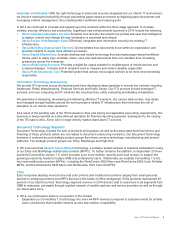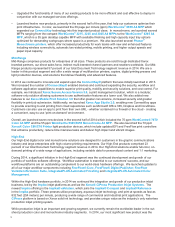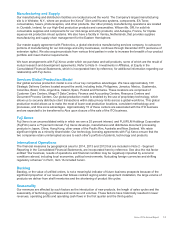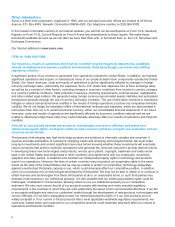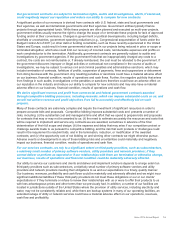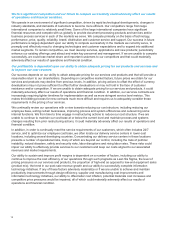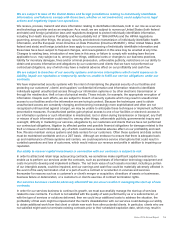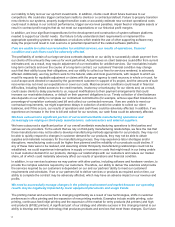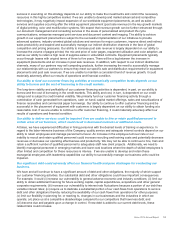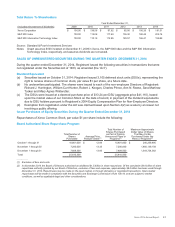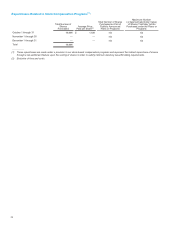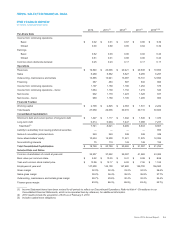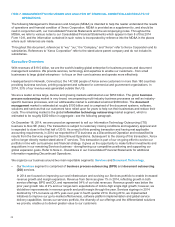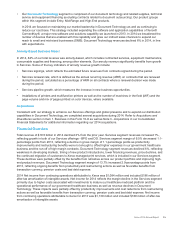Xerox 2014 Annual Report Download - page 32
Download and view the complete annual report
Please find page 32 of the 2014 Xerox annual report below. You can navigate through the pages in the report by either clicking on the pages listed below, or by using the keyword search tool below to find specific information within the annual report.our inability to fully recover our up-front investments. In addition, clients could direct future business to our
competitors. We could also trigger contractual credits to clients or a contractual default. Failure to properly transition
new clients to our systems, properly budget transition costs or accurately estimate new contract operational costs
could result in delays in our contract performance, trigger service level penalties, impair fixed or intangible assets or
result in contract profit margins that do not meet our expectations or our historical profit margins.
In addition, we incur significant expenditures for the development and construction of system software platforms
needed to support our clients' needs. Our failure to fully understand client requirements or implement the
appropriate operating systems or databases or solutions which enable the use of other supporting software may
delay the project and result in cost overruns or potential impairment of the related software platforms.
If we are unable to collect our receivables for unbilled services, our results of operations, financial
condition and cash flows could be adversely affected.
The profitability of certain of our large services contracts depends on our ability to successfully obtain payment from
our clients of the amounts they owe us for work performed. Actual losses on client balances could differ from current
estimates and, as a result, may require adjustment of our receivables for unbilled services. Our receivables include
long-term contracts and over the course of a long-term contract, our customers' financial condition may change
such that their ability to pay their obligations, and our ability to collect our fees for services rendered, is adversely
affected. Additionally, we may perform work for the federal, state and local governments, with respect to which we
must file requests for equitable adjustment or claims with the proper agency to seek recovery in whole or in part, for
out-of-scope work directed or caused by the government customer in support of its project, and the amounts of such
recoveries may not meet our expectations or cover our costs. Macroeconomic conditions could result in financial
difficulties, including limited access to the credit markets, insolvency or bankruptcy, for our clients and, as a result,
could cause clients to delay payments to us, request modifications to their payment arrangements that could
increase our receivables balance, or default on their payment obligations to us. Timely collection of client balances
also depends on our ability to complete our contractual commitments (for example, achieve specified milestones in
percentage-of-completion contracts) and bill and collect our contracted revenues. If we are unable to meet our
contractual requirements, we might experience delays in collection of and/or be unable to collect our client
balances, and if this occurs, our results of operations and cash flows could be adversely affected. In addition, if we
experience an increase in the time to bill and collect for our services, our cash flows could be adversely affected.
We have outsourced a significant portion of our overall worldwide manufacturing operations and
increasingly are relying on third-party manufacturers, subcontractors and external suppliers.
We have outsourced a significant portion of our overall worldwide manufacturing operations to third parties and
various service providers. To the extent that we rely on third-party manufacturing relationships, we face the risk that
those manufacturers may not be able to develop manufacturing methods appropriate for our products, they may not
be able to quickly respond to changes in customer demand for our products, they may not be able to obtain
supplies and materials necessary for the manufacturing process, they may experience labor shortages and/or
disruptions, manufacturing costs could be higher than planned and the reliability of our products could decline. If
any of these risks were to be realized, and assuming similar third-party manufacturing relationships could not be
established, we could experience interruptions in supply or increases in costs that might result in our being unable
to meet customer demand for our products, damage our relationships with our customers and reduce our market
share, all of which could materially adversely affect our results of operations and financial condition.
In addition, in our services business we may partner with other parties, including software and hardware vendors, to
provide the complex solutions required by our customers. Therefore, our ability to deliver the solutions and provide
the services required by our customers is dependent on our and our partners' ability to meet our customers'
requirements and schedules. If we or our partners fail to deliver services or products as required and on time, our
ability to complete the contract may be adversely affected, which may have an adverse impact on our revenue and
profits.
We need to successfully manage changes in the printing environment and market because our operating
results may be negatively impacted by lower equipment placements and usage trends.
The printing market and environment is changing significantly as a result of new technologies, shifts in customer
preferences in office printing and the expansion of new printing markets. Examples include mobile printing, color
printing, continuous feed inkjet printing and the expansion of the market for entry products (A4 printers) and high-
end products (B1/B2 printers). A significant part of our strategy and ultimate success in this changing market is our
ability to develop and market technology that produces products and services that meet these changes. Our future
17



